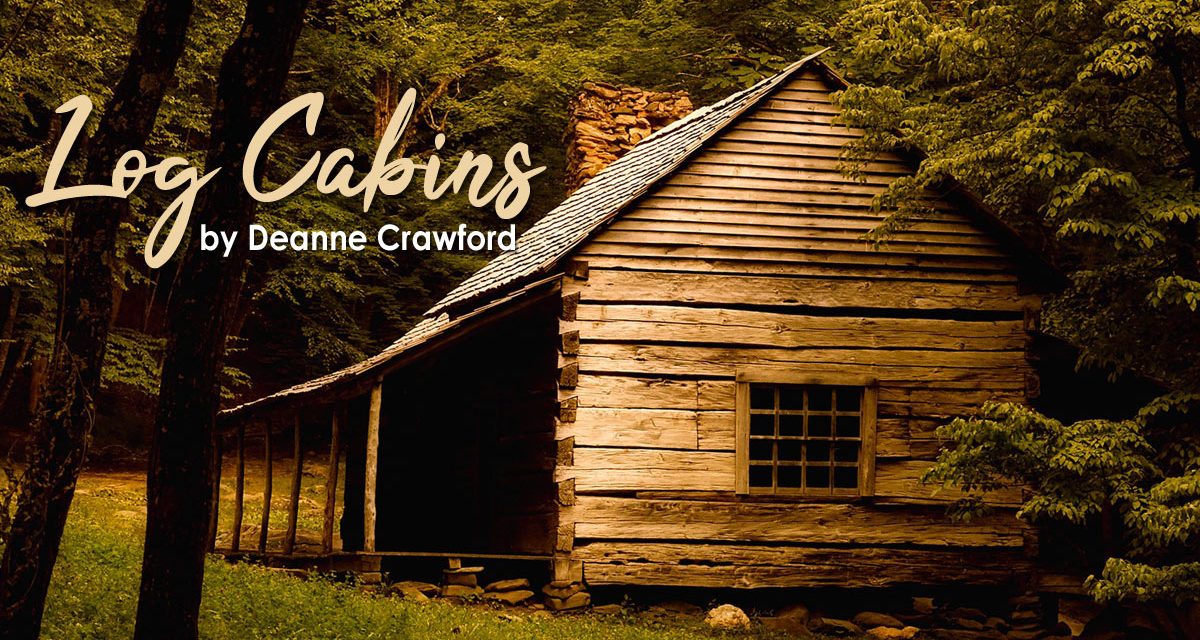Log cabins are a part of our American heritage, a reminder of simpler times when families lived, worked, and played together. Did you know that June 25th has been set aside to celebrate the log cabin? This month, I invite your family to celebrate this humble home. Before we begin, note the web links to family friendly sites for further exploration.
Introduce your study by having children build a log cabin. Plan ahead and allow children ample time to create their ideal log cabin. Lincoln Logs® provide an excellent opportunity for creating an authentic log cabin. If Lincoln Logs® are not available, craft or Popsicle® sticks can be used to construct a log cabin. Littlest ones will appreciate the easy log cabin craft from All Kid’s Network or challenge older ones with Education.com’s Popsicle Stick Log Cabin.
Before we start our Log Cabin study-take this quick rabbit trail! Have you ever wondered how Lincoln logs were invented? Inducted into the National Toy Hall of Fame in 1999 (YES! It is a real place) Lincoln Logs were invented by John Lloyd Wright, the son of famous architect, Frank Lloyd Wright. Mr. Wright was well known for his creative buildings, with a self-described “organic” architectural style. Learn more about Mr. Wright here, take a virtual tour of his designs here, and explore your own creativity through activities from the Frank Lloyd Wright Trust Kids and Family Activity website. Mr. Wright and his son, John, worked together sporadically until he fired his son for paying himself out of his father’s accounts. The relationship was complex, and sadly, not one of Mr. Wright’s greatest moments. (Parents, if you would like your older children to understand more about this complex relationship, Incredible @rt Department is an educator’s resource that provides excellent biographical information.) John was heavily influenced by his father’s legacy. From early childhood, John was encouraged to create and even owned a dedicated building room where he spent hours building with Froebel blocks. Created in Germany in 1830, Froebel blocks were made to help children learn geometric form, mathematics and creative design. His time creating led him to develop his own design style as he grew into adulthood. Learn more about the beloved Lincoln Logs® at History.com!
Back to our Log Cabin study! Once your children have finished building, ask them to describe their model log cabin. How is it different than their home? While a few may reside in a simple log cabin, most children will be able to point out that the log cabin is one large room (compared to numerous rooms or levels in your home). Allow them to identify as many differences as possible. Then ask them if there are any similarities. If you have the opportunity, visit a log cabin with your children. You can also check out the Living History’s Pioneer Log Cabin Tour on You-Tube®. Located in Oregon, this replica log cabin is similar to the ones built by Oregon Trail pioneers in the mid-1800s. Ask them to describe what it might have felt like to live in a log cabin. Camp Silos offers a brief description that is a great conversation starter!
In early America, a log cabin was carefully constructed to last for years. Built from trees found close to the building site, the trees were chopped down, trimmed and notched using hand tools. Most had an open floor plan, meaning that there were no walls to separate the kitchen from the bedroom or living room. Often this one room had a ladder going up to a loft. The main room was small, approximately 14’x 14’. If you have a tape measure handy, use it to measure your living room, or a bedroom. Compare the size of a similar room in your home to the size of the log cabin. How would it feel to live in this room with your entire family? In addition to the small size, most cabins were built with only 1 door which faced south, a stone fireplace and only 1 or 2 windows. Glass windows were rare in early America because they were expensive. Most windows were made from greased paper, which was cheaper and provided protection from weather. Cabin ceilings were low about 7’ high. Lower ceilings over a small room made it easy for the fireplace to warm the cabin during the fierce winter months. If you would like to learn more about building log cabins, check out Building Log Cabin Walls and Handmade Log Building with Primitive Tools.
Would you be surprised to learn that log cabins did not originate in the United States? It is believed that the first known use of a log home was around 3500 BC in Northern European (Germany and Scandinavia), where tall, straight trees were readily available. With your children, identify Germany and the Scandinavian countries (Norway, Sweden and Denmark) on a world map. Have your children choose one of the Northern European countries to learn more about: Germany, Norway, Sweden or Denmark. Older children can compare and contrast each of the countries. Have them share what they learn. By the time Europeans began to settle in America in the early 1600s, there was a long tradition of using logs for houses (as well as barns) in Scandinavian countries and Germany. Interestingly, these log-cabins were considered temporary. Built by pioneers with little or no cash, they used easy-to-find materials. While today we view life in a log cabin as a normal part of life, you may be surprised to learn that in early days of America, log cabins were considered a humble dwelling of the poor. In fact, many of the first log cabins had dirt floors!
Log cabins were not only popular in Northern Europe. Fun fact: there is evidence of homes built by logs and stacked together in the Roman Empire! While most of us think of homes in Ancient Rome being made from stone or marble, Roman architect, Vitruvius Pollio wrote about homes made by laying logs horizontally over the top of each other in his book De Architectura.
Our study has just skimmed the surface of the fun and fascinating log cabin history. I hope this has inspired you to learn more! In recent years, there has been a tremendous resurgence in log cabins and many families have chosen to build their dream house in logs. While today’s log homes offer more space and rooms, the vision to create a simple, family centered lifestyle remains. It’s my hope that this study has reignited a love for family and creativity. ~Deanne
Products
Log Cabin Wood Model Kit (1-8)
Bring history alive with these historical craft kits. Kits include precut wooden pieces, any small nails or fasteners needed, and easy to follow instructions. You will need to supply a few easy to find materials.
https://www.rainbowresource.com/product/060825/Log-Cabin-Wood-Model-Kit.html
Log Cabin Small Format Sticker Book (PK-AD)
Perfect for little hands, these sticker books allow younger ones to create their own log cabin experience!
https://www.rainbowresource.com/product/013067/Log-Cabin-Small-Format-Sticker-Activity-Book.html
Lincoln Logs (not my favorite choice but only one in stock with a graphic) (K-AD)
https://www.rainbowresource.com/product/023914/Horseshoe-Hill-Station-Lincoln-Logs.html?
Bring the classics home! Log homes, farms and lodges are just some of the possibilities with a classic Lincoln Log® set!
Not for the faint of heart, the “World’s Smallest Lincoln Logs” allows you to challenge your skills as you build an authentic, miniature size log cabin! (K-AD)
https://www.rainbowresource.com/product/013564/Worlds-Smallest-Lincoln-Logs.html?
Pioneer Sampler (K-6)
https://www.rainbowresource.com/product/006491/Pioneer-Sampler.html
Learn more about the cabin living in Pioneer times through the life of the Robertson family. Hands on activities will bring history alive for your children!
Frontier Living (4-7)
Immerse yourself yourself in the character and culture of the men and women who conquered the American frontier! Well illustrated, with well written text, children and parents alike will be transported back to the trials and the joys of early America.





